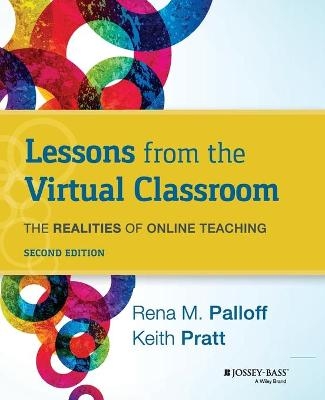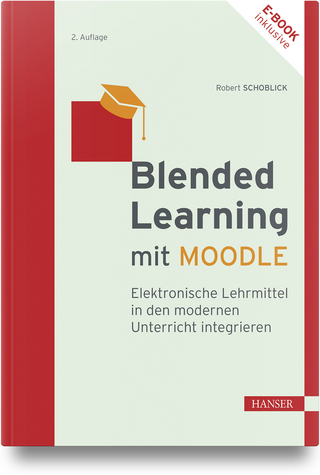
Lessons from the Virtual Classroom
Jossey-Bass Inc.,U.S. (Verlag)
978-1-118-12373-7 (ISBN)
Lessons from the Virtual Classroom, Second Edition
The second edition of the classic resource Lessons from the Cyberspace Classroom offers a comprehensive reference for faculty to hone their skills in becoming more effective online instructors. Thoroughly revised and updated to reflect recent changes and challenges that face online teachers, Lessons from the Virtual Classroom is filled with illustrative examples from actual online courses as well as helpful insights from teachers and students. This essential guide offers targeted suggestions for dealing with such critical issues as evaluating effective courseware, working with online classroom dynamics, addressing the needs of the online student, making the transition to online teaching, and promoting the development of the learning community.
Praise for Lessons from the Virtual Classroom, Second Edition
"Palloff and Pratt demonstrate their exceptional practical experience and insight into the online classroom. This is an invaluable resource for those tasked with creating an online course."
D. Randy Garrison, professor, University of Calgary, and author, Blended Learning in Higher Education: Framework, Principles, and Guidelines
"Faculty will deeply appreciate and make use of the many explicit examples of how to design, prepare, and teach both blended and fully online courses."
Judith V. Boettcher, faculty coach and author, The Online Teaching Survival Guide: Simple and Practical Pedagogical Tips
"Lessons from the Virtual Classroom is filled with insightful caveats and recommendations, pointed examples to enhance your practice, succinct summaries of the research, and engaging visual overviews. Each page brings the reader a renewed sense of confidence to teach online as well as personal joy that there is finally a resource to find the answers one is seeking."
Curtis J. Bonk, professor of education, Indiana University-Bloomington, and author, Empowering Online Learning: 100+ Activities for Reading, Reflecting, Displaying, and Doing
Rena M. Palloff and Keith Pratt have consulted to universities in the development and delivery of online learning since 1994. In conjunction with Fielding Graduate University, they developed the Online Teaching and Learning academic certificate program. They are the authors of Lessons from the Cyberspace Classroom, The Virtual Student, Collaborating Online, Building Online Learning Communities, Assessing Online Learning, and The Excellent Online Instructor all from Jossey-Bass.
Figures, Table, and Exhibits xi
Preface to the Second Edition: The Face of Online Learning Today xiii
The Authors xix
Acknowledgments xxi
Part One: Rethinking Education for an Online World 1
1 Online Learning in the Twenty-First Century 3
Online Learning Today 6
Current and Emerging Technologies 8
Emerging Issues for Both Faculty and Administrators 9
Technology for Online Teaching Is Chosen Without Faculty Input • Governance Issues Have Emerged • Intellectual Property, Course Design, and Course Ownership Issues • Just Like Faculty, Students Need to Be Trained to Learn Online • Instructor Workload
Recent Developments in K–12 Online Learning 16
The Effectiveness of Distance Delivery 18
2 The Art of Online Teaching 21
Lack of Preparation 22
Who Should Teach Online? 23
Training, Training, and More Training 24
Using Mobile Technology in Faculty Training 27
New Processes, New Relationships 28
Online Pedagogy 30
Keys to Success 30
Ensuring Access to and Familiarity with Technology • Establishing Guidelines and Procedures • Achieving Maximum Participation • Promoting Collaboration • Promoting Reflection
The Final Transition: Assessing and Evaluating Students and Ourselves 41
Supporting Instructors to Make the Transition 43
3 Administrative Issues and Concerns 45
Faculty Time, Compensation, and Questions of Tenure 47
Program Planning and Development 49
Another Look at Faculty and Student Support, Training, and Development 52
Governance and Intellectual Property 54
Student Retention 56
Some Last Thoughts on Administrative Issues and Concerns 58
4 The Tools of Online Teaching 61
Technology in the Twenty?]First Century 62
Matching the Technology to the Course 64
What Are Web 2.0 Technologies? 70
Common Forms of Web 2.0 Technologies • Using Web 2.0 Tools in Online Courses Choosing Technology Wisely 75
When the Technology Is a Problem • Evaluating Technology • Use of Technology • Infrastructure • Instructional Strategy
When Money Is an Issue 81
Accessibility Is a Major Concern 82
Part Two: Teaching and Learning Online 85
5 Transforming Courses for the Online Classroom 87
Starting Over: Considerations in the Development of an Online Course 89
Who Are My Students? • Is This a Course That Will Successfully Transfer to the Online Environment? • How Do I Define Learning in This Content Area, and What Do I Want to See as the Learning Outcomes? • What Do I Want to Accomplish Through This Course? • What Guidelines, Rules, Roles, and Norms Need to Be Established for Course Completion? • How Do I Plan to Deliver Course Material? • How Comfortable Am I in Releasing Control to the Learners? • How Do I Want to Organize the Course Site? • How Will I Assess Student Performance in This Course? • How Will I Address Attendance Requirements?
The Process of the Course 106
Beginnings • Once the Course Has Started • Endings
6 Teaching Courses Developed by Others 119
A Focus on Content 121
Ability to Adjust the Course 122
Examples of Customization 123
When Customizing Is Not Possible 124
Building Community into the Process 125
Evaluating a Course Developed by Another 126
Issues of Intellectual Property 129
Courses with Rolling Admission 130
Final Thoughts on Teaching a Course Developed by Another 132
7 Working with the Virtual Student 135
If We Build It, They Will Come 136
The Successful Learner in the Online Classroom 137
Addressing Different Learning Styles 140
Recognizing and Working with Those Who Do Not Succeed 141
The Role of the Learner in the Online Learning Process 142
Knowledge Generation • Collaboration • Process Management Maximizing the Potential of the Virtual Student 148
Use Best Practices from the Face?]to?]Face Classroom to Promote Participation Online • If a Student Is Absent for a Week, Contact Him or Her to Determine the Reason • If Students Have Technical Difficulties, Offer Support or Connect Them with Tech Support • If Conflict Hurts Participation, Intercede with the Students Involved • If Security Breaches Cause Nonparticipation, Report Them Quickly to Reestablish a Sense of Privacy • Log On to the Online Classroom Three or More Times a Week (Daily If Possible!) to Keep the Discussion Moving • Learn How to Ask Broad Questions That Stimulate Thinking to Promote Participation • Include Humor in Your Posts to Help Students Feel Welcome and Safe • Post a Welcoming Response to Student Introductions to Help All Join More Successfully
Teaching Students to Learn in the Online Environment 154
Respecting Student Intellectual Property 156
8 Online Classroom Dynamics 159
Group Dynamics and Online Classroom Dynamics 160
Applying What We Understand About Groups to Online Classes 163
Preforming • Unity • Disunity • Conflict?]Confrontation • Disharmony • Harmony • Performing • Concluding Thoughts About the Soul and Spirit Group Other Ways of Looking at Online Groups 171 The Student • The Group • The Instructor/Facilitator • The Task • The Technology Conflict Revisited 175
Working with Difficult Students 179
When It Simply Isn’t Working 181
9 Lessons Learned in the Virtual Classroom 187
A Look Back 187
The Myths 188
Lessons for Faculty 189
Instructors Need Not Fear Online Learning • Course Development Needs to Focus on Interactivity, Not Content • Instructor and Student Roles Need to Change Lessons for Instructional Designers and Faculty Developers 191
Both Faculty and Students Need Training • Faculty Who Teach Online Need to Feel Supported Lessons for Administrators 192
Support Online Faculty Through Fair Compensation • Institutions Should Develop a Strategic Plan • Institutions Should Develop an Infrastructure First • Technology Should Be Chosen by an Inclusive Committee • Pay Attention to the New Regulatory Environment
A Look into the Near Future 195
Technology • Course and Program Quality and Design • Professional Development • How Faculty and Students Interact • Research into Online Education
Appendix A: Sample Training for Faculty 203
Introduction to and Best Practices in Online Teaching 203
LEARNING UNITS • Week 1 • Week 2 • Week 3 • Week 4 Intensive Training Focused on Collaboration and Building Online Learning Communities 212
Day 1: Defining and Recontextualizing Community • Day 2: Human and Practical Considerations in Online Learning • Day 3: Moving Teaching and Learning Online • Day 4: Promoting Collaborative Learning • Day 5: Transformative Learning
Appendix B: Additional Resources 219
Communities of Practice 219
Mobile Applications and Web 2.0 Applications 220
Certificate Programs in Online Teaching 221
Online Conferences 222
Online Journals About Online Teaching 223
Professional Organizations 223
Course Evaluation Rubrics 224
References 225
Index 235
| Erscheint lt. Verlag | 1.11.2017 |
|---|---|
| Verlagsort | New York |
| Sprache | englisch |
| Maße | 178 x 234 mm |
| Gewicht | 408 g |
| Themenwelt | Schulbuch / Wörterbuch ► Unterrichtsvorbereitung ► Unterrichts-Handreichungen |
| Sozialwissenschaften ► Pädagogik ► Bildungstheorie | |
| ISBN-10 | 1-118-12373-5 / 1118123735 |
| ISBN-13 | 978-1-118-12373-7 / 9781118123737 |
| Zustand | Neuware |
| Haben Sie eine Frage zum Produkt? |
aus dem Bereich


